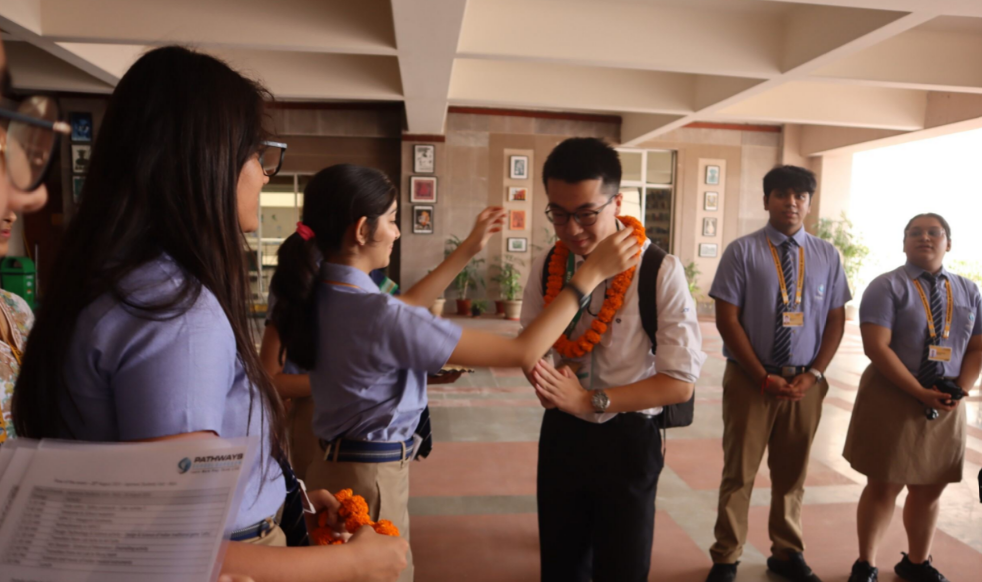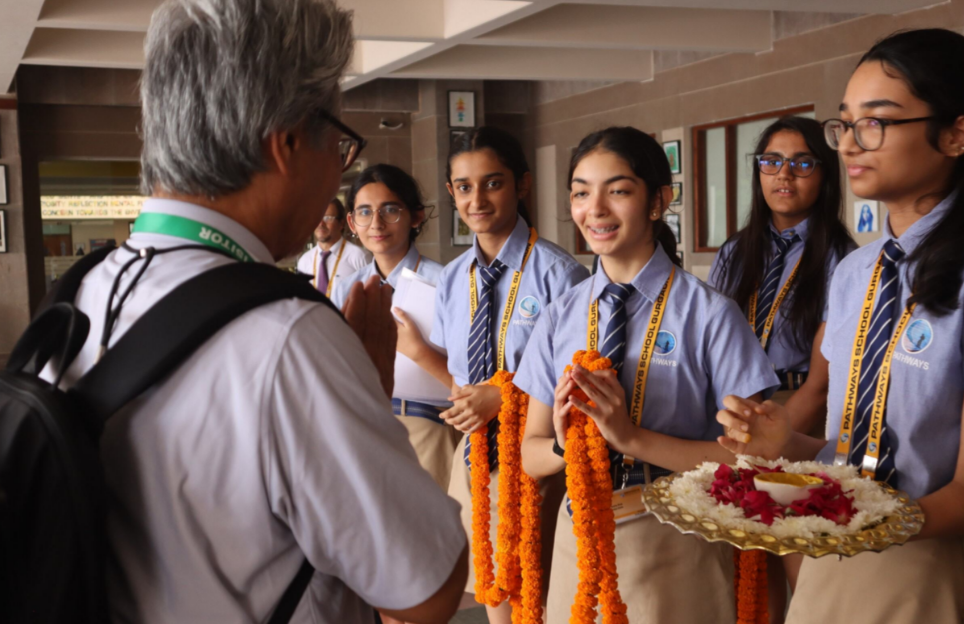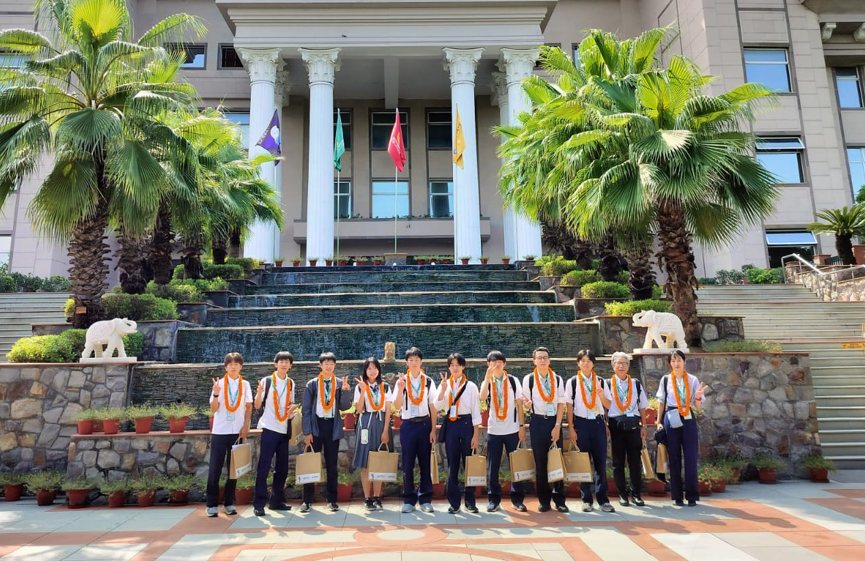
Nilay Jain
PYP 5

Nilay Jain
PYP 5

Saanvi Sehgal
PYP 5

Arush Nath
MYP 4

Arjun Sabherwal
MYP 4

Diya Mehra
MYP 4

Arav Agarwal
MYP 5

Arhan Singhal
MYP 5

Aanya Tulsyan
DPCP 1

Oshwin Dang
DPCP 1

Abhyuthan Srivastava
DPCP 1

Yashraj Garg
DPCP 1

Nilay Jain
PYP 5

Saanvi Sehgal
PYP 5

Arush Nath
MYP 4

Arjun Sabherwal
MYP 4

Diya Mehra
MYP 4

Arav Agarwal
MYP 5

Arhan Singhal
MYP 5

Aanya Tulsyan
DPCP 1

Oshwin Dang
DPCP 1

Abhyuthan Srivastava
DPCP 1

Yashraj Garg
DPCP 1
The opening ceremony began at 11 AM, an hour later than its scheduled time as a result of the guests’ late arrivals. The Emcees – Diya Sawhny and Anoushka Jolly from DP1 introduced the event and welcomed the guests. Thereafter, the lamp-lighting took place where Anya Sharma sang the accompanying Shloka. The ceremony continued with speeches from Ms. Dimpu and Dr. Namita Gupta from the Department of Science and Technology. Subsequently, all the guests from the department, as well as the teachers, were felicitated. After the announcement of the student buddies, the emcees outlined the schedule for the day’s events. The ceremony concluded with everyone enjoying the refreshments laid out.
The first activity was a lesson on Indian toys led by Risi Sahu, specifically "Lattus" (spinning tops), which demonstrated the principles of physics in action. Following this, participants moved to the arts department, where they explored the chemistry behind the enamelling of metal plates, gaining insight into how science enhances the delicate art form.
The day continued in the musical department, where students Trisha Rajkumar (MYP 5) and Raghav Banerjee (DP1) led an exploration of the physics behind traditional Indian instruments, including the tabla, sarod, sitar, and pakhawaj. This session deepened the students’ understanding of how sound is produced and how these instruments contribute to the art of Bharatnatyam.
Reflections from Advisor & Student at Hokuto Municipal Koryo Junior and Senior High School
Mr. Yuji Nishikawa from Hokuto Municipal Koryo Junior and Senior High School shared his enthusiastic reflections on his recent visit. He was particularly impressed by the school's infrastructure, which he found to be in "exceptionally great condition" and “reflective of a high standard of care”. Mr. Nishikawa noted the profound respect the students and staff demonstrated towards the school property, which he found noteworthy. His observations extended to the various educational programs, including Design and Technology, Visual Arts, and Music. He was pleased to find "superior facilities" and "experienced teachers" who provided valuable guidance. The diversity of forms within each discipline highlighted the school’s commitment to a well-rounded educational experience. A personal highlight for him was learning enamel painting, a new skill he enthusiastically embraced. Culturally, he was deeply moved by the "harmony in diversity" present in Indian culture. He observed that, despite the varied artistic and musical expressions, there was a unified message of respect and spirituality. This learning of the integration of diverse elements into a cohesive cultural narrative left a significant impact on him.
Additionally, one of the students–Tomoki Iwai–mentioned he had an exceptionally enriching experience, marked by new and surprising insights. He was notably impressed by the expansive and diverse facilities, which exceeded his expectations and left a lasting positive impression. In the Design segment, he discovered the Indian spinning top, or "Lattoo," a traditional toy popular among younger people for its captivating entertainment value. He was particularly fascinated by the integration of physics, specifically the rotational axis, which illustrated a practical application of scientific principles. In the realm of Music, Tomoki was intrigued by the complexity of Carnatic music, especially its intricate rhythms. He admired the skill required for memorizing these rhythms, which sparked his interest in learning more about this musical tradition. Furthermore, Tomoki enhanced his English communication skills, effectively conveying his observations despite language challenges. Overall, the visit broadened his cultural and educational perspectives, but one of his primary takeaways were that it left him eager to further explore Carnatic music and its rhythms.
Reflections from the Department of Science and Technology
Dr. Namita Gupta, a representative of the Indian government, expressed deep appreciation for the environment at Pathways School Gurgaon and its holistic approach to education during her visit. She was particularly impressed by the inclusion of music, dance, and arts as 'mainstream subjects' in the curriculum. Dr. Namita noted that the school's infrastructure was 'excellent,' with multiple classrooms and dedicated spaces for arts, dance, music, sports, and design, all meticulously maintained. The clean and green surroundings added to the beauty and tranquillity of the space, making it a propitious and conducive environment for learning.
Throughout the reflection, Ms. Namita expressed how impressed they were by the enriching experiences offered in the visual arts, performing arts, and music departments. They were particularly struck by how these subjects are integrated into the core curriculum, providing students with practical experiences that promote cultural understanding and personal growth. This hands-on approach allows students to actively engage with their learning, encouraging them to explore their passions and develop their skills in a nurturing environment. She was particularly impressed with the ease and comfort with which the Japanese interacted with the Indians, all thanks to the friendly environment created by the students and teachers at Pathways.
One of the key takeaways for the visitors was the school's commitment to preserving and promoting Indian culture. They were pleased to see how the school, as one of the "international board" delved into aspects of Indian heritage, such as the study of ‘Sanskrit’ and the strong following of ‘Vasudev Krishna’, creating a strong sense of cultural identity among students. This focus on cultural education ensures that students are not only aware of their own heritage but also respectful and appreciative of the diverse backgrounds of their peers. Additionally, the government representatives learned about new skills being imparted to students, like the art of enamelling, further allowing students to focus on deeper aspects of Indian techniques.
Reflections from Students involved in the program
Student from Japan: Mizuki Kubota, shared that his experience at the school was incredibly rewarding, filled with meaningful interactions and cultural insights. He was particularly taken by the school's infrastructure, finding the campus beautiful, with the fountain outside and the spacious, well-decorated rooms making a lasting positive impression. In the Design segment, Mizuki discovered the Indian spinning top, or "Lattoo," which resonated with him as it reminded him of a similar toy in Japan. In the realm of Music, Mizuki was particularly drawn to the intricacies of Indian music, especially the rhythms of the tabla, which he connected with due to his experience playing drums in Japan. This experience piqued his interest in learning more about Indian musical instruments, particularly the harmonium, which he hopes to explore further on a future visit to India. Finally, Misuki also learned a new skill in using glass paint, enhancing his appreciation for the detailed artistry involved. Overall, his visit enriched his cultural awareness and left him eager to continue exploring Indian traditions and music.
Student instructor: Arush Nath of DP 1 presented to students how he utilized the disciplines of science and design to create his personal project product – SAWT: the world’s first ever Solar-powered AI-enabled Waste-sorting Trash bin. This was a great experience for him as he was able to share with the Japanese students India’s unique waste-mismanagement problem and motivate them to innovate against the issue.
Student volunteer: “As I watched over the day's events unfold, it was truly fascinating to witness the level of engagement displayed by the students. From the very start, it was evident that the activities planned for the day were resonating deeply with everyone involved.”
Collated by: Anoushka Jolly, Diya Sawhny, Saira Dua (DP1)



Consistently ranked #1 Best International School in Gurgaon, Delhi, Faridabad - Education World C Fore Survey
 Baliawas Off Gurugram Faridabad Road, Gurugram – 122003
Baliawas Off Gurugram Faridabad Road, Gurugram – 122003 [email protected]
[email protected]Drop us your details for a quick response.
Copyright 2023 © Pathways School Gurgaon. All rights reserved.
Design and Development by Sterco Digitex